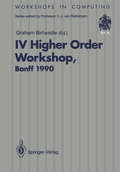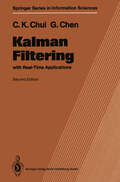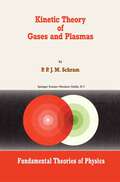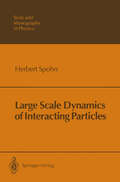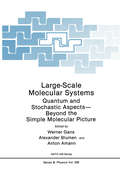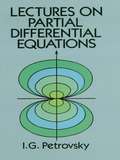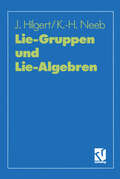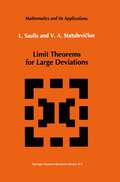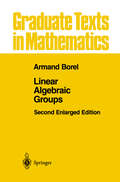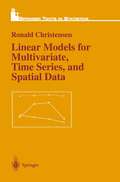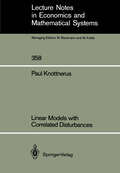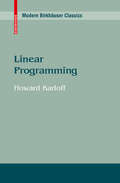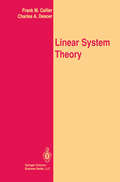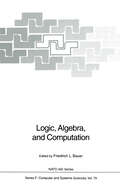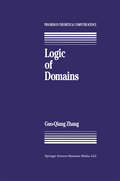- Table View
- List View
Irrtum und Erkenntnis: Fehlerquellen im Erkenntnisprozeß von Biologie und Medizin (Naturwissenschaften-Bibliothek)
by Ulrich BässlerDie Praxis der Erkenntnisgewinnung in den Bio-Wissenschaften arbeitet nach einem allgemein anerkannten Kanon von Verhaltensvorschriften, der sich auf Grund von Erfahrungen in der Forschungspraxis und nicht durch die theoretischen Reflexionen der Erkenntnistheorie herausgebildet hat. Er besteht zum großen Teil darin, potentielle Fehlerquellen zu vermeiden. Solche Fehlerquellen sind in dem hier vorliegenden Band zum ersten Mal systematisch zusammengestellt worden, wobei diejenigen Bereiche, in denen sich die Methoden der Bio-Wissenschaften von denen der Physik und Chemie unterscheiden, ausführlicher dargestellt werden. Viele leicht verständliche Beispiele erläutern das Gesagte. Das Buch wendet sich an alle Studenten, die im Studium bio-wissenschaftliche Erkenntnisse erwerben sowie an die Forscher, die diese Erkenntnisse dann in der Praxis anwenden. Sie alle sollen ein Gefühl für die Sicherheit einer Aussage bekommen, die Denkweisen bio-wissenschaftlicher Forschung kennenzulernen und Fehler bei der eigenen Arbeit vermeiden lernen.
Issues in Contemporary Economics: Volume 2: Macroeconomics and Econometrics (International Economic Association Series)
by Marc NerloveThis is the second volume of the proceedings of the IEA Congress in Athens. Part 1 on macroeconomics considers aspects of unemployment, both generally in a Keynesian framework and in more detail, while Part 2 discusses international aspects of macroeconomic fluctuations and macroeconomic equilibrium associated with the development of the European Community. Part 3 on econometrics deals particularly with the use of survey data and microeconomic theory to analyse decisions important to the understanding of macroeconomic fluctuations and expectation formation.
ITSM: An Interactive Time Series Modelling Package for the PC
by Peter J. Brockwell Richard A. DavisDesigned for the analysis of linear time series and the practical modelling and prediction of data collected sequentially in time. It provides the reader with a practical understanding of the six programs contained in the ITSM software (PEST, SPEC, SMOOTH, TRANS, ARVEC, and ARAR). This IBM compatible software is included in the back of the book on two 5 1/4'' diskettes and on one 3 1/2 '' diskette. - Easy to use menu system - Accessible to those with little or no previous compu- tational experience - Valuable to students in statistics, mathematics, busi- ness, engineering, and the natural and social sciences. This package is intended as a supplement to the text by the same authors, "Time Series: Theory and Methods." It can also be used in conjunction with most undergraduate and graduate texts on time series analysis.
IV Higher Order Workshop, Banff 1990: Proceedings of the IV Higher Order Workshop, Banff, Alberta, Canada 10–14 September 1990 (Workshops in Computing)
by Graham BirtwistleIt is many years since Landin, Burge and others showed us how to apply higher order techniques and thus laid some foundations for modern functional programming. The advantage of higher order descriptions - that they can be very succinct and clear - has been percolating through ever since. Current research topics range from the design, implementation and use of higher order proof assistants and theorem provers, through program specification and verification, and programming language design, to its applications in hardware description and verification. The papers in this book represent the presentations made at a workshop held at Banff, Canada, September 10-14 1990 and organised by the Computer Science Department of the University of Calgary. The workshop gathered together researchers interested in applying higher order techniques to a range of problems. The workshop format had a few (but fairly long) presentations per day. This left ample time for healthy discussion and argument, many of which continued on into the small hours. With so much to choose from, the program had to be selective. This year's workshop was divided into five parts: 1. Expressing and reasoning about concurrency: Warren Burton and Ken Jackson, John Hughes, and Faron Moller. 2. Reasoning about synchronous circuits: Geraint Jones and Mary Sheeran (with a bonus on the fast Fourier transform from Geraint). 3. Reasoning about asynchronous circuits: Albert Camilleri, Jo Ebergen, and Martin Rem. 4. Categorical concepts for programming languages: Robin Cockett, Barry Jay, and Andy Pitts.
Kalman Filtering: with Real-Time Applications (Springer Series in Information Sciences #17)
by Charles K. Chui Guanrong ChenIn addition to making a number of minor corrections and updat ing the references, we have expanded the section on "real-time system identification" in Chapter 10 of the first edition into two sections and combined it with Chapter 8. In its place, a very brief introduction to wavelet analysis is included in Chapter 10. Although the pyramid algorithms for wavelet decompositions and reconstructions are quite different from the Kalman filtering al gorithms, they can also be applied to time-domain filtering, and it is hoped that splines and wavelets can be incorporated with Kalman filtering in the near future. College Station and Houston Charles K. Chui September 1990 Guanrong Chen Preface to the First Edition Kalman filtering is an optimal state estimation process applied to a dynamic system that involves random perturbations. More precisely, the Kalman filter gives a linear, unbiased, and min imum error variance recursive algorithm to optimally estimate the unknown state of a dynamic system from noisy data taken at discrete real-time. It has been widely used in many areas of industrial and government applications such as video and laser tracking systems, satellite navigation, ballistic missile trajectory estimation, radar, and fire control. With the recent development of high-speed computers, the Kalman filter has become more use ful even for very complicated real-time applications.
Kinetic Theory of Gases and Plasmas (Fundamental Theories of Physics #46)
by PPJM SchramKinetic theory is the link between the non--equilibrium statistical mechanics of many particle systems and macroscopic or phenomenological physics. Therefore much attention is paid in this book both to the derivation of kinetic equations with their limitations and generalizations on the one hand, and to the use of kinetic theory for the description of physical phenomena and the calculation of transport coefficients on the other hand. The book is meant for researchers in the field, graduate students and advanced undergraduate students. At the end of each chapter a section of exercises is added not only for the purpose of providing the reader with the opportunity to test his understanding of the theory and his ability to apply it, but also to complete the chapter with relevant additions and examples that otherwise would have overburdened the main text of the preceding sections. The author is indebted to the physicists who taught him Statistical Mechanics, Kinetic Theory, Plasma Physics and Fluid Mechanics. I gratefully acknowledge the fact that much of the inspiration without which this book would not have been possible, originated from what I learned from several outstanding teachers. In particular I want to mention the late Prof. dr. H. C. Brinkman, who directed my first steps in the field of theoretical plasma physics, my thesis advisor Prof. dr. N. G. Van Kampen and Prof. dr. A. N. Kaufman, whose course on Non-Equilibrium Statistical Mechanics in Berkeley I remember with delight.
Large Scale Dynamics of Interacting Particles (Theoretical and Mathematical Physics)
by Herbert SpohnThis book deals with one of the fundamental problems of nonequilibrium statistical mechanics: the explanation of large-scale dynamics (evolution differential equations) from models of a very large number of interacting particles. This book addresses both researchers and students. Much of the material presented has never been published in book-form before.
Large-Scale Molecular Systems: Quantum and Stochastic Aspects—Beyond the Simple Molecular Picture (Nato Science Series B: #258)
by Werner Gans Alexander Blumen Anton AmannThis NATO Advanced Study Institute centered on large-scale molecular systems: Quantum mechanics, although providing a general framework for the description of matter, is not easily applicable to many concrete systems of interest; classical statistical methods, on the other hand, allow only a partial picture of the behaviour of large systems. The aim of the ASI was to present both aspects of the subject matter and to foster interaction between the scientists working in these important areas of theoretical physics and theoretical chemistry. The quantum-mechanical part was mostly based on the operator-algebraic formulation of quantum mechanics and comprised quantum statistics of infinite systems with special em phasis on macroscopic observables, equilibrium conditions, irreversibility on the one hand, symmetry breaking for molecules in the radiation field and macroscopic quantum phenomena in the theory of superconductivity (BCS-theory) on the other hand. In addition, phase-space methods for many-body systems were also presented. Statistical physics was the main topic in the other lectures of the School; much emphasis was put on the statistical features of macros copic ("large") systems, the lectures dealt with mass and energy transport im polymers, in gels and in microemulsions, with aggregation and growth phenomena, with relaxation in complex, correlated systems, with conduction and optical properties of polymers, and with the means of describing disordered systems, above all fractals and related hierarchical models.
Lectures on Applications-Oriented Mathematics (Wiley Classics Library #33)
by Bernard FriedmanMeets the need for a program of short courses involving the essentials of a number of mathematical topics taken by physics and engineering students. Basically applications-oriented, the courses do include selected topics of abstract mathematics. While several courses can be used as practical appendices to conventional mathematics, others serve as introductions, providing motivation for self-study in areas of conceptual math.
Lectures on Partial Differential Equations
by I. G. PetrovskyThe field of partial differential equations is an extremely important component of modern mathematics. It has great intrinsic beauty and virtually unlimited applications. This book, written for graduate-level students, grew out of a series of lectures the late Professor Petrovsky gave at Moscow State University. The first chapter uses physical problems to introduce the subjects and explains its division into hyperbolic, elliptic, and parabolic partial differential equations. Each of these three classes of equations is dealt with in one of the remaining three chapters of the book in a manner that is at once rigorous, transparent, and highly readable.Petrovsky was a leading figure in Russian mathematics responsible for many advances in the field of partial differential equations. In these masterly lectures, his commentary and discussion of various aspects of the problems under consideration will prove valuable in deepening students’ understanding and appreciation of these problems.
Lehrbuch der Analysis: Teil 2 (Mathematische Leitfäden)
by Harro Heuser"Das Werk ist eine didaktische Meisterleistung" (ZAMP). "Dieses großartige [Lehrbuch] ... ist mit überall durchschimmerndem Engagement, ja mit Begeisterung geschrieben" (ZAMM). "The author succeeds convincingly in showing how the rich carpet of analysis with its infinitely manifold colors and figures is woven from a few threads (the axioms on real numbers) more and more thightly and ... how rich and deep the inner relations between its concepts and procedures are" (Math. Rev.)
Lie-Gruppen und Lie-Algebren
by Joachim Hilgert Karl-Hermann NeebDieses Buch versteht sich als Einführung in die Theorie der Lie-Gruppen. Der Begriff der Lie-Gruppen wird ausgehend von den einfachsten Beispielen, den Matrizengruppen, entwickelt. Eine große Anzahl von Problemen für Lie-Gruppen kann man durch Übertragung auf die zugehörigen Lie-Algebren lösen. Dies ist der Leitgedanke des Buches. Vorausgesetzt werden Kenntnisse in der Linearen Algebra, der Differentialrechnung mehrerer Variablen und der elementaren Gruppentheorie.
Limit Theorems for Large Deviations (Mathematics and its Applications #73)
by L. Saulis V.A. StatuleviciusLinear Algebraic Groups (Graduate Texts in Mathematics #126)
by Armand BorelThis revised, enlarged edition of Linear Algebraic Groups (1969) starts by presenting foundational material on algebraic groups, Lie algebras, transformation spaces, and quotient spaces. It then turns to solvable groups, general properties of linear algebraic groups, and Chevally’s structure theory of reductive groups over algebraically closed groundfields. It closes with a focus on rationality questions over non-algebraically closed fields.
Linear Models for Multivariate, Time Series, and Spatial Data (Springer Texts in Statistics)
by Ronald ChristensenThis is a self-contained companion volume to the authors book "Plane Answers to Complex Questions: The Theory of Linear Models". It provides introductions to several topics related to linear model theory: multivariate linear models, discriminant analysis, principal components, factor analysis, time series in both the frequency and time domains, and spatial data analysis (geostatistics). The purpose of this volume is to use the three fundamental ideas of best linear prediction, projections, and Mahalanobis' distance to exploit their properties in examining multivariate, time series and spatial data. Ronald Christensen is Professor of Statistics at the University of New Mexico, and is recognised internationally as an expert in the theory and application of linear models.
Linear Models with Correlated Disturbances (Lecture Notes in Economics and Mathematical Systems #358)
by Paul KnottnerusIn each chapter of this volume some specific topics in the econometric analysis of time series data are studied. All topics have in common the statistical inference in linear models with correlated disturbances. The main aim of the study is to give a survey of new and old estimation techniques for regression models with disturbances that follow an autoregressive-moving average process. In the final chapter also several test strategies for discriminating between various types of autocorrelation are discussed. In nearly all chapters it is demonstrated how useful the simple geometric interpretation of the well-known ordinary least squares (OLS) method is. By applying these geometric concepts to linear spaces spanned by scalar stochastic variables, it emerges that well-known as well as new results can be derived in a simple geometric manner, sometimes without the limiting restrictions of the usual derivations, e. g. , the conditional normal distribution, the Kalman filter equations and the Cramer-Rao inequality. The outline of the book is as follows. In Chapter 2 attention is paid to a generalization of the well-known first order autocorrelation transformation of a linear regression model with disturbances that follow a first order Markov scheme. Firstly, the appropriate lower triangular transformation matrix is derived for the case that the disturbances follow a moving average process of order q (MA(q». It turns out that the calculations can be carried out either analytically or in a recursive manner.
Linear Programming (Modern Birkhäuser Classics)
by Howard KarloffTo this reviewer’s knowledge, this is the first book accessible to the upper division undergraduate or beginning graduate student that surveys linear programming…. Style is informal. ...Recommended highly for acquisition, since it is not only a textbook, but can also be used for independent reading and study. —Choice Reviews This is a textbook intended for advanced undergraduate or graduate students. It contains both theory and computational practice. —Zentralblatt Math
Linear Spaces with Few Lines (Lecture Notes in Mathematics #1490)
by Klaus MetschA famous theorem in the theory of linear spaces states that every finite linear space has at least as many lines as points. This result of De Bruijn and Erd|s led to the conjecture that every linear space with "few lines" canbe obtained from a projective plane by changing only a small part of itsstructure. Many results related to this conjecture have been proved in the last twenty years. This monograph surveys the subject and presents several new results, such as the recent proof of the Dowling-Wilsonconjecture. Typical methods used in combinatorics are developed so that the text can be understood without too much background. Thus the book will be of interest to anybody doing combinatorics and can also help other readers to learn the techniques used in this particular field.
Linear System Theory (Springer Texts in Electrical Engineering)
by Frank M. Callier Charles A. DesoerThis book is the result of our teaching over the years an undergraduate course on Linear Optimal Systems to applied mathematicians and a first-year graduate course on Linear Systems to engineers. The contents of the book bear the strong influence of the great advances in the field and of its enormous literature. However, we made no attempt to have a complete coverage. Our motivation was to write a book on linear systems that covers finite dimensional linear systems, always keeping in mind the main purpose of engineering and applied science, which is to analyze, design, and improve the performance of phy sical systems. Hence we discuss the effect of small nonlinearities, and of perturbations of feedback. It is our on the data; we face robustness issues and discuss the properties hope that the book will be a useful reference for a first-year graduate student. We assume that a typical reader with an engineering background will have gone through the conventional undergraduate single-input single-output linear systems course; an elementary course in control is not indispensable but may be useful for motivation. For readers from a mathematical curriculum we require only familiarity with techniques of linear algebra and of ordinary differential equations.
Lineare Algebra (Springer-Lehrbuch)
by Klaus JänichHier im Hause habe ich vor allem Frau Hertl zu danken, die das 'IEX-Skript geschrieben hat und Herrn Michael Prechtel, der zur Lösung schwieriger 1EX Probleme so manche Stunde für uns abgezweigt hat. Auch Frau Zirngibl danke ich für Ihre Mithilfe bei der Vorbereitung des Manuskripts. Kurz vor Ablauf des Termins schließlich, wenn sich der Fleiß zur Hektik steigert, hätte ich ohne den Einsatz meiner Mitarbeiter Martin Lercher und Robert Mandl wie ein Formel-I-Fahrer dagestanden, der während des Rennens seine Reifen selber wechseln soll. Ihnen allen sei herzlich gedankt. Regensburg, im August 1991 Klaus J änich Inhaltsverzeichnis 1. Mengen und Abbildungen 1. 1 Mengen . . . . . . . . . . . . . . . . . . . . . . . . . . . . . . . . . . . . . . . . . . . . . . . . . . . . . . . 1 1. 2 Abbildungen . . . . . . . . . . . . . . . . . . . . . . . . . . . . . . . . . . . . . . . . . . . . . . . . . . 8 1. 3 Test . . . . . . . . . . . . . . . . . . . . . . . . . . . . . . . . . . . . . . . . . . . . . . . . . . . . . . . . . 14 1. 4 Literaturhinweis . . . . . . . . . . . . . . . . . . . . . . . . . . . . . . . . . . . . . . . . . . . . . 16 1. 5 Übungen . . . . . . . . . . . . . . . . . . . . . . . . . . . . . . . . . . . . . . . . . . . . . . . . . . . . 18 2. Vektorräume 2. 1 Reelle Vektorräume . . . . . . . . . . . . . . . . . . . . . . . . . . . . . . . . . . . . . . . . . . 20 2. 2 Komplexe Zahlen und Komplexe Vektorräume . . . . . . . . . . . . . . . . 26 2. 3 Untervektorräume . . . . . . . . . . . . . . . . . . . . . . . . . . . . . . . . . . . . . . . . . . . 30 2. 4 Test . . . . . . . . . . . . . . . . . . . . . . . . . . . . . . . . . . . . . . . . . . . . . . . . . . . . . . . . . 33 2. 5 Körper (Ein Abschnitt für Mathematiker) . . . . . . . . . . . . . . . . . . . . 34 2. 6 Was sind Vektoren? (Ein Abschnitt für Physiker) . . . . . . . . . . . . 38 2. 7 Komplexe Zahlen vor 400 Jahren (Historische Notiz) . . . . . . . . . 50 2. 8 Literaturhinweis . . . . . . . . . . . . . . . . . . . . . . . . . . . . . . . . . . . . . . . . . . . . . 51 2. 9 Übungen . . . . . . . . . . . . . . . . . . . . . . . . . . . . . . . . . . . . . . . . . . . . . . . . . . . . 52 3. Dimensionen 3. 1 Lineare Unabhängigkeit . . . . . . . . . . . . . . . . . . . . . . . . . . . . . . . . . . . . . . 56 3. 2 Der Dimensionsbegriff . . . . . . . . . . . . . . . . . . . . . . . . . . . . . . . . . . . . . . . 59 3. 3 Test . . . . . . . . . . . . . . . . . . . . . . . . . . . . . . . . . . . . . . . . . . . . . . . . . . . . . . . . . 64 3. 4 Beweis des Basisergänzungssatzes und des Austaus- lemmas (Ein Abschnitt für Mathematiker) . . . . . . . . . . . . . . . . . . . 66 3. 5 Das Vektorprodukt (Ein Abschnitt für Physiker) . . . . . . . . . . . . . 69 3. 6 Der "Steinitzsche Austauschsatz" (Historische Notiz) . . . . . . . . 75 3. 7 Literaturhinweis . . . . . . . . . . . . . . . . . . . . . . . . . . . . . . . . . . . . . . . . . . . . . 77 3. 8 Übungen . . . . . . . . . . . . . . . . . . . . . . . . . . . . . . . . . . . . . . . . . . . . . . . . . . . . 77 VIII INHALTSVERZEICHNIS 4. Lineare Abbildungen 4. 1 Lineare Abbildungen . . . . . . . . . . . . . . . . . . . . . . . . . . . . . . . . . . . . . . . . . 80 4. 2 Matrizen . . . . . . . . . . . . . . . . . . . . . . . . . . . . . . . . . . . . . . . . . . . . . . . . . . . .
Lineare Algebra (Birkhäuser Skripten #3)
by B. ArtmannDies Skript enthält den Standards toff der Linearen Algebra, wie er in den ersten Semestern üblich ist. Es wurde in verschiedenen Formen zu Vorlesungen herausgegeben, die ich für Studenten der Mathematik, Physik und Informatik an der Technischen Hochschule Darmstadt gehalten habe. Ich habe mir Mühe gegeben, den Text so einfach und leicht zugänglich wie möglich zu schreiben und jeweils typische Beispiele zu finden, um Sätze und Begriffe zu illustrieren. Die Lineare Algebra kann man unter drei Aspekten sehen: geometrisch im Sinne der analytischen Geometrie, arithmetisch wie bei den Linearen Gleichungssystemen und vielen Teilen der Matrizenrechnung, die für die Numerik wichtig sind, und schließlich strukturbetont-abstrakt in der linearen und bilinearen Theorie der Vektorräume. Alle drei Aspekte soll ten in einer Einführung zur Geltung kommen, so auch in diesem Skript. Allerdings habe ich versucht, die begriffliche Behandlung eines Stoffes so weit wie möglich ans Ende der jeweiligen Paragraphen zu stellen, um vorher über Geometrie und Arithmetik eine verläßliche Intuition für den Gegenstand aufzubauen. Diesem Zweck dienen besonders die einführenden 2 Abschnitte über die geometrischen Verhältnisse im E . Gerade hier hat der Student, der ja die weitere Theorie noch nicht überblicken kann, die Gelegenheit, aus der anschaulichen Fundierung den Sinn und die Be deutung der Begriffe und Fragestellungen zu begreifen und damit von einer vernünftigen Basis aus weiterzuarbeiten.
The Little Book of Bigger Primes
by Paulo RibenboimThis book could have been called "Selections from the Book of Prime Number Records." However, I prefered the title which propelled you on the first place to open it, and perhaps (so I hope) to buy it! Richard K. Guy, with his winning ways, suggested the title to me, and I am grateful. But the book isn't very different from its parent. Like a bonsai, which has all the main characteristics of the full-sized tree, this little paperback should exert the same fatal attraction. I wish it to be as dangerous as the other one, in the saying of John Brillhart. I wish that you, young student, teacher or retired mathematician, engineer, computer buff, all of you who are friends of numbers, to be driven into thinking about the beautiful theory of prime numbers, with its inherent mystery. I wish you to exercise your brain and fingers-not vice-versa. But I do not wish you, specialist in number theory to look at this little book-most likely you have been eliminated from this shorter version-what a terrible feeling. But do not cry, you had your book already. This one is for those who will be taking over and should put their steps forward, mostly little, occasionally giant, to develop the science of numbers. Paulo Ribenboim Contents Preface vii Guiding the Reader xii Index of Notations xiii Introduction 1 1 How Many Prime Numbers Are There? 3 I. Euclid's Proof .. 3 11. Kummer's Proof 4 II. P6lya's Proof . .
Lmsst: 24 Lectures On Elliptic Curves (PDF) (London Mathematical Society Student Texts #24)
by J. W. S. Cassels C. M. Series J. W. BruceThe study of (special cases of) elliptic curves goes back to Diophantos and Fermat, and today it is still one of the liveliest centres of research in number theory. This book, which is addressed to beginning graduate students, introduces basic theory from a contemporary viewpoint but with an eye to the historical background. The central portion deals with curves over the rationals: the Mordell-Weil finite basis theorem, points of finite order (Nagell-Lutz) etc. The treatment is structured by the local-global standpoint and culminates in the description of the Tate-Shafarevich group as the obstruction to a Hasse principle. In an introductory section the Hasse principle for conics is discussed. The book closes with sections on the theory over finite fields (the 'Riemann hypothesis for function fields') and recently developed uses of elliptic curves for factoring large integers. Prerequisites are kept to a minimum; an acquaintance with the fundamentals of Galois theory is assumed, but no knowledge either of algebraic number theory or algebraic geometry is needed. The p-adic numbers are introduced from scratch, as is the little that is needed on Galois cohomology. Many examples and exercises are included for the reader. For those new to elliptic curves, whether they are graduate students or specialists from other fields, this will be a fine introductory text.
Logic, Algebra, and Computation: International Summer School (NATO ASI Subseries F: #79)
by F. L. Bauer W. Brauer G. Huet J. A. Robinson H. SchwichtenbergThe Marktoberdorf Summer Schools on Informatics were started in 1970, with the intention to convene every second or third year a group of top researchers in computing, devoted to preach their most recent results to an elite of advanced students - young and most promising people - and prepared to stand their questions, criticism and suggestions. The themes of these Advanced Study In stitutes under the sponsorship of the NATO Scientific Affairs Division varied slightly over the years, oscillating more or less around Programming Methodo logy, as the following list shows: 1970 Data Structures and Computer Systems 1971 Program Structures and Fundamental Concepts of Programming 1973 Structured Programming and Programmed Structures 1975 Language Hierarchies and Interfaces 1978 Program Construction 1981 Theoretical Foundations of Programming Methodology 1984 Control Flow and Data Flow: Concepts of Distributed Programming 1986 Logic of Programming and Calculi of Discrete Design 1988 Constructive Methods in Computing Science 1989 Logic, Algebra, and Computation Logic, Algebra, and Computation is the theme of the summer school to which this volume is devoted. It is the tenth in succession, but it is also the first in a new series (the "blue" series) that is intended to alternate in future with the traditional (the "red" series) arrangement; in fact the tenth summer school in the "red" series with the title "Programming and Mathematical Method" , held in 1990, was the subject of celebrating both its serial number and the twenty years of Marktoberdorf Summer Schools altogether.
Logic of Domains (Progress in Theoretical Computer Science)
by G. ZhangThis monograph studies the logical aspects of domains as used in de notational semantics of programming languages. Frameworks of domain logics are introduced; these serve as foundations for systematic derivations of proof systems from denotational semantics of programming languages. Any proof system so derived is guaranteed to agree with denotational se mantics in the sense that the denotation of any program coincides with the set of assertions true of it. The study focuses on two categories for dena tational semantics: SFP domains, and the less standard, but important, category of stable domains. The intended readership of this monograph includes researchers and graduate students interested in the relation between semantics of program ming languages and formal means of reasoning about programs. A basic knowledge of denotational semantics, mathematical logic, general topology, and category theory is helpful for a full understanding of the material. Part I SFP Domains Chapter 1 Introduction This chapter provides a brief exposition to domain theory, denotational se mantics, program logics, and proof systems. It discusses the importance of ideas and results on logic and topology to the understanding of the relation between denotational semantics and program logics. It also describes the motivation for the work presented by this monograph, and how that work fits into a more general program. Finally, it gives a short summary of the results of each chapter. 1. 1 Domain Theory Programming languages are languages with which to perform computa tion.



